- Home
- ABOUT US
- ABOUT VEYSEL BABA
- REDFOX ART HOUSE VIRTUAL TOUR
- MY LAST WILL TESTAMENT
- NOTES ON HUMANITY AND LIFE
- HUMAN BEING IS LIKE A PUZZLE WITH CONTRADICTIONS
- I HAVE A WISH ON BEHALF OF THE HUMANITY
- WE ARE VERY EXHAUSTED AS THE DOOMSDAY IS CLOSER
- NO ROAD IS LONG WITH GOOD COMPANY
- THE ROAD TO A FRIENDS HOUSE IS NEVER LONG
- MY DREAMS 1
- MY DREAMS 2
- GOLDEN WORDS ABOUT POLITICS
- GOLDEN WORDS ABOUT LOVE
- GOLDEN WORDS ABOUT LIFE
- GOLDEN WORDS ABOUT DEATH
- VEYSEL BABA ART WORKS
- SHOREDITCH PARK STORIES
- EXAMPLE LIVES
- ART GALLERY
- BOOK GALLERY
- MUSIC GALLERY
- MOVIE GALLERY
- Featured Article
- Home
- EXAMPLE LIVES
- Harizmi
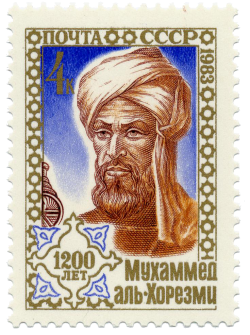
Harizmi
Muḥammad ibn Mūsā al-Khwārizmī[note 1] (Persian: محمد بن موسی خوارزمی, Arabic: محمد بن موسى الخوارزمی; c. 780 – c. 850), formerly Latinized as Algoritmi,[note 2] was a Persian[3][4] (modern Khiva, Uzbekistan) mathematician, astronomer, and geographer during the Abbasid Caliphate, a scholar in the House of Wisdom in Baghdad.
In the 12th century, Latin translations of his work on the Indian numerals introduced the decimal positional number system to the Western world.[5] Al-Khwārizmī's The Compendious Book on Calculation by Completion and Balancing presented the first systematic solution of linear and quadratic equations in Arabic. He is often considered one of the fathers of algebra.[6][7] He revised Ptolemy's Geography and wrote on astronomy and astrology.
Some words reflect the importance of al-Khwārizmī's contributions to mathematics. "Algebra" is derived from al-jabr, one of the two operations he used to solve quadratic equations. Algorism and algorithm stem from Algoritmi, the Latin form of his name.[8] His name is also the origin of (Spanish) guarismo[9] and of (Portuguese) algarismo, both meaning digit.
Life
Few details of al-Khwārizmī's life are known with certainty. He was born in a Persian[4] family and Ibn al-Nadim gives his birthplace as Khwarezm[10] in Greater Khorasan (modern Khiva, Xorazm Region, Uzbekistan).
Muhammad ibn Jarir al-Tabari gives his name as Muḥammad ibn Musá al-Khwārizmiyy al-Majūsiyy al-Quṭrubbaliyy (محمد بن موسى الخوارزميّ المجوسـيّ القطربّـليّ). The epithet al-Qutrubbulli could indicate he might instead have come from Qutrubbul (Qatrabbul),[11] a viticulture district near Baghdad. However, Rashed[12] suggests:
There is no need to be an expert on the period or a philologist to see that al-Tabari's second citation should read "Muhammad ibn Mūsa al-Khwārizmī and al-Majūsi al-Qutrubbulli," and that there are two people (al-Khwārizmī and al-Majūsi al-Qutrubbulli) between whom the letter wa [Arabic 'و' for the conjunction 'and'] has been omitted in an early copy. This would not be worth mentioning if a series of errors concerning the personality of al-Khwārizmī, occasionally even the origins of his knowledge, had not been made. Recently, G. J. Toomer ... with naive confidence constructed an entire fantasy on the error which cannot be denied the merit of amusing the reader.
Regarding al-Khwārizmī's religion, Toomer writes:
Another epithet given to him by al-Ṭabarī, "al-Majūsī," would seem to indicate that he was an adherent of the old Zoroastrian religion. This would still have been possible at that time for a man of Iranian origin, but the pious preface to al-Khwārizmī's Algebra shows that he was an orthodox Muslim, so al-Ṭabarī's epithet could mean no more than that his forebears, and perhaps he in his youth, had been Zoroastrians.[13]
Ibn al-Nadīm's Kitāb al-Fihrist includes a short biography on al-Khwārizmī together with a list of the books he wrote. Al-Khwārizmī accomplished most of his work in the period between 813 and 833. After the Muslim conquest of Persia, Baghdad became the centre of scientific studies and trade, and many merchants and scientists from as far as China and India traveled to this city, as did al-Khwārizmī[citation needed]. He worked in Baghdad as a scholar at the House of Wisdom established by Caliph al-Ma’mūn, where he studied the sciences and mathematics, which included the translation of Greek and Sanskrit scientific manuscripts.
Douglas Morton Dunlop suggests that it may have been possible that Muḥammad ibn Mūsā al-Khwārizmī was in fact the same person as Muḥammad ibn Mūsā ibn Shākir, the eldest of the three Banū Mūsā.[14][year missing]
Contributions
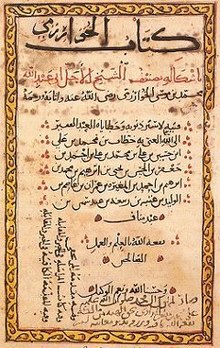
Al-Khwārizmī's contributions to mathematics, geography, astronomy, and cartography established the basis for innovation in algebra and trigonometry. His systematic approach to solving linear and quadratic equations led to algebra, a word derived from the title of his 830 book on the subject, "The Compendious Book on Calculation by Completion and Balancing".
On the Calculation with Hindu Numerals written about 825, was principally responsible for spreading the Hindu–Arabic numeral system throughout the Middle East and Europe. It was translated into Latin as Algoritmi de numero Indorum. Al-Khwārizmī, rendered as (Latin) Algoritmi, led to the term "algorithm".
Some of his work was based on Persian and Babylonian astronomy, Indian numbers, and Greek mathematics.
Al-Khwārizmī systematized and corrected Ptolemy's data for Africa and the Middle East. Another major book was Kitab surat al-ard ("The Image of the Earth"; translated as Geography), presenting the coordinates of places based on those in the Geography of Ptolemy but with improved values for the Mediterranean Sea, Asia, and Africa.[citation needed]
He also wrote on mechanical devices like the astrolabe and sundial.
He assisted a project to determine the circumference of the Earth and in making a world map for al-Ma'mun, the caliph, overseeing 70 geographers.[15]
When, in the 12th century, his works spread to Europe through Latin translations, it had a profound impact on the advance of mathematics in Europe.[citation needed]
Algebra

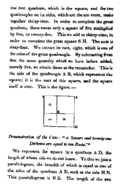
The Compendious Book on Calculation by Completion and Balancing (Arabic: الكتاب المختصر في حساب الجبر والمقابلة al-Kitāb al-mukhtaṣar fī ḥisāb al-jabr wal-muqābala) is a mathematical book written approximately 830 CE. The book was written with the encouragement of Caliph al-Ma'mun as a popular work on calculation and is replete with examples and applications to a wide range of problems in trade, surveying and legal inheritance.[16] The term "algebra" is derived from the name of one of the basic operations with equations (al-jabr, meaning "restoration", referring to adding a number to both sides of the equation to consolidate or cancel terms) described in this book. The book was translated in Latin as Liber algebrae et almucabala by Robert of Chester (Segovia, 1145) hence "algebra", and also by Gerard of Cremona. A unique Arabic copy is kept at Oxford and was translated in 1831 by F. Rosen. A Latin translation is kept in Cambridge.[17]
It provided an exhaustive account of solving polynomial equations up to the second degree,[18] and discussed the fundamental methods of "reduction" and "balancing", referring to the transposition of terms to the other side of an equation, that is, the cancellation of like terms on opposite sides of the equation.[19]
Al-Khwārizmī's method of solving linear and quadratic equations worked by first reducing the equation to one of six standard forms (where b and c are positive integers)
- squares equal roots (ax2 = bx)
- squares equal number (ax2 = c)
- roots equal number (bx = c)
- squares and roots equal number (ax2 + bx = c)
- squares and number equal roots (ax2 + c = bx)
- roots and number equal squares (bx + c = ax2)
by dividing out the coefficient of the square and using the two operations al-jabr (Arabic: الجبر "restoring" or "completion") and al-muqābala ("balancing"). Al-jabr is the process of removing negative units, roots and squares from the equation by adding the same quantity to each side. For example, x2 = 40x − 4x2 is reduced to 5x2 = 40x. Al-muqābala is the process of bringing quantities of the same type to the same side of the equation. For example, x2 + 14 = x + 5 is reduced to x2 + 9 = x.
The above discussion uses modern mathematical notation for the types of problems which the book discusses. However, in al-Khwārizmī's day, most of this notation had not yet been invented, so he had to use ordinary text to present problems and their solutions. For example, for one problem he writes, (from an 1831 translation)
If some one say: "You divide ten into two parts: multiply the one by itself; it will be equal to the other taken eighty-one times." Computation: You say, ten less thing, multiplied by itself, is a hundred plus a square less twenty things, and this is equal to eighty-one things. Separate the twenty things from a hundred and a square, and add them to eighty-one. It will then be a hundred plus a square, which is equal to a hundred and one roots. Halve the roots; the moiety is fifty and a half. Multiply this by itself, it is two thousand five hundred and fifty and a quarter. Subtract from this one hundred; the remainder is two thousand four hundred and fifty and a quarter. Extract the root from this; it is forty-nine and a half. Subtract this from the moiety of the roots, which is fifty and a half. There remains one, and this is one of the two parts.[16]
In modern notation this process, with 'x' the "thing" (شيء shayʾ) or "root", is given by the steps,
- {\displaystyle (10-x)^{2}=81x}
- {\displaystyle x^{2}-20x+100=81x}
- {\displaystyle x^{2}+100=101x}
Let the roots of the equation be 'p' and 'q'. Then {\displaystyle {\tfrac {p+q}{2}}=50{\tfrac {1}{2}}}

- {\displaystyle {\frac {p-q}{2}}={\sqrt {\left({\frac {p+q}{2}}\right)^{2}-pq}}={\sqrt {2550{\tfrac {1}{4}}-100}}=49{\tfrac {1}{2}}}
So a root is given by
- {\displaystyle x=50{\tfrac {1}{2}}-49{\tfrac {1}{2}}=1}
Several authors have also published texts under the name of Kitāb al-jabr wal-muqābala, including Abū Ḥanīfa Dīnawarī, Abū Kāmil Shujāʿ ibn Aslam, Abū Muḥammad al-‘Adlī, Abū Yūsuf al-Miṣṣīṣī, 'Abd al-Hamīd ibn Turk, Sind ibn ‘Alī, Sahl ibn Bišr, and Sharaf al-Dīn al-Ṭūsī.
J. J. O'Conner and E. F. Robertson wrote in the MacTutor History of Mathematics archive:
Perhaps one of the most significant advances made by Arabic mathematics began at this time with the work of al-Khwarizmi, namely the beginnings of algebra. It is important to understand just how significant this new idea was. It was a revolutionary move away from the Greek concept of mathematics which was essentially geometry. Algebra was a unifying theory which allowed rational numbers, irrational numbers, geometrical magnitudes, etc., to all be treated as "algebraic objects". It gave mathematics a whole new development path so much broader in concept to that which had existed before, and provided a vehicle for future development of the subject. Another important aspect of the introduction of algebraic ideas was that it allowed mathematics to be applied to itself in a way which had not happened before.[20]
R. Rashed and Angela Armstrong write:
Al-Khwarizmi's text can be seen to be distinct not only from the Babylonian tablets, but also from Diophantus' Arithmetica. It no longer concerns a series of problems to be resolved, but an exposition which starts with primitive terms in which the combinations must give all possible prototypes for equations, which henceforward explicitly constitute the true object of study. On the other hand, the idea of an equation for its own sake appears from the beginning and, one could say, in a generic manner, insofar as it does not simply emerge in the course of solving a problem, but is specifically called on to define an infinite class of problems.[21]

Arithmetic
Al-Khwārizmī's second major work was on the subject of arithmetic, which survived in a Latin translation but was lost in the original Arabic. The translation was most likely done in the 12th century by Adelard of Bath, who had also translated the astronomical tables in 1126.
The Latin manuscripts are untitled, but are commonly referred to by the first two words with which they start: Dixit algorizmi ("So said al-Khwārizmī"), or Algoritmi de numero Indorum ("al-Khwārizmī on the Hindu Art of Reckoning"), a name given to the work by Baldassarre Boncompagni in 1857. The original Arabic title was possibly Kitāb al-Jam‘ wat-Tafrīq bi-Ḥisāb al-Hind[22] ("The Book of Addition and Subtraction According to the Hindu Calculation").[23]
Al-Khwārizmī's work on arithmetic was responsible for introducing the Arabic numerals, based on the Hindu-Arabic numeral system developed in Indian mathematics, to the Western world. The term "algorithm" is derived from the algorism, the technique of performing arithmetic with Hindu-Arabic numerals developed by al-Khwārizmī. Both "algorithm" and "algorism" are derived from the Latinized forms of al-Khwārizmī's name, Algoritmi and Algorismi, respectively.
Astronomy
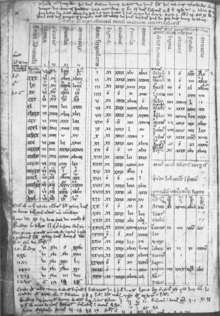
Al-Khwārizmī's Zīj al-Sindhind[13] (Arabic: زيج السند هند, "astronomical tables of Sindh and Hind") is a work consisting of approximately 37 chapters on calendrical and astronomical calculations and 116 tables with calendrical, astronomical and astrological data, as well as a table of sine values. This is the first of many Arabic Zijes based on the Indian astronomical methods known as the sindhind.[24] The work contains tables for the movements of the sun, the moon and the five planets known at the time. This work marked the turning point in Islamic astronomy. Hitherto, Muslim astronomers had adopted a primarily research approach to the field, translating works of others and learning already discovered knowledge.
The original Arabic version (written c. 820) is lost, but a version by the Spanish astronomer Maslamah Ibn Ahmad al-Majriti (c. 1000) has survived in a Latin translation, presumably by Adelard of Bath (January 26, 1126).[25] The four surviving manuscripts of the Latin translation are kept at the Bibliothèque publique (Chartres), the Bibliothèque Mazarine (Paris), the Biblioteca Nacional (Madrid) and the Bodleian Library (Oxford).
Trigonometry
Al-Khwārizmī's Zīj al-Sindhind also contained tables for the trigonometric functions of sines and cosine.[24] A related treatise on spherical trigonometry is also attributed to him.[20]
Geography


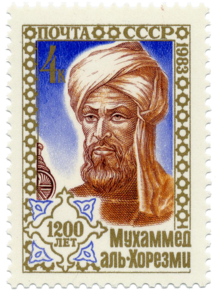
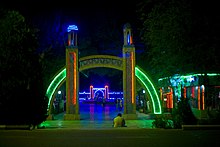
Al-Khwārizmī's third major work is his Kitāb Ṣūrat al-Arḍ (Arabic: كتاب صورة الأرض, "Book of the Description of the Earth"),[26] also known as his Geography, which was finished in 833. It is a major reworking of Ptolemy's 2nd-century Geography, consisting of a list of 2402 coordinates of cities and other geographical features following a general introduction.[27]
There is only one surviving copy of Kitāb Ṣūrat al-Arḍ, which is kept at the Strasbourg University Library. A Latin translation is kept at the Biblioteca Nacional de España in Madrid.[citation needed] The book opens with the list of latitudes and longitudes, in order of "weather zones", that is to say in blocks of latitudes and, in each weather zone, by order of longitude. As Paul Gallez[dubious – discuss] points out, this excellent system allows the deduction of many latitudes and longitudes where the only extant document is in such a bad condition as to make it practically illegible. Neither the Arabic copy nor the Latin translation include the map of the world itself; however, Hubert Daunicht was able to reconstruct the missing map from the list of coordinates. Daunicht read the latitudes and longitudes of the coastal points in the manuscript, or deduces them from the context where they were not legible. He transferred the points onto graph paper and connected them with straight lines, obtaining an approximation of the coastline as it was on the original map. He then does the same for the rivers and towns.[28]
Al-Khwārizmī corrected Ptolemy's gross overestimate for the length of the Mediterranean Sea[29] from the Canary Islands to the eastern shores of the Mediterranean; Ptolemy overestimated it at 63 degrees of longitude, while al-Khwārizmī almost correctly estimated it at nearly 50 degrees of longitude. He "also depicted the Atlantic and Indian Oceans as open bodies of water, not land-locked seas as Ptolemy had done."[30] Al-Khwārizmī's Prime Meridian at the Fortunate Isles was thus around 10° east of the line used by Marinus and Ptolemy. Most medieval Muslim gazetteers continued to use al-Khwārizmī's prime meridian.[29]
Jewish calendar
Al-Khwārizmī wrote several other works including a treatise on the Hebrew calendar, titled Risāla fi istikhrāj ta’rīkh al-yahūd (Arabic: رسالة في إستخراج تأريخ اليهود, "Extraction of the Jewish Era"). It describes the Metonic cycle, a 19-year intercalation cycle; the rules for determining on what day of the week the first day of the month Tishrei shall fall; calculates the interval between the Anno Mundi or Jewish year and the Seleucid era; and gives rules for determining the mean longitude of the sun and the moon using the Hebrew calendar. Similar material is found in the works of Abū Rayḥān al-Bīrūnī and Maimonides.[13]
Other works
Ibn al-Nadim's Kitāb al-Fihrist, an index of Arabic books, mentions al-Khwārizmī's Kitāb al-Taʾrīkh (Arabic: كتاب التأريخ), a book of annals. No direct manuscript survives; however, a copy had reached Nusaybin by the 11th century, where its metropolitan bishop, Mar Elyas bar Shinaya, found it. Elias's chronicle quotes it from "the death of the Prophet" through to 169 AH, at which point Elias's text itself hits a lacuna.[31]
Several Arabic manuscripts in Berlin, Istanbul, Tashkent, Cairo and Paris contain further material that surely or with some probability comes from al-Khwārizmī. The Istanbul manuscript contains a paper on sundials; the Fihrist credits al-Khwārizmī with Kitāb ar-Rukhāma(t) (Arabic: كتاب الرخامة). Other papers, such as one on the determination of the direction of Mecca, are on the spherical astronomy.
Two texts deserve special interest on the morning width (Ma‘rifat sa‘at al-mashriq fī kull balad) and the determination of the azimuth from a height (Ma‘rifat al-samt min qibal al-irtifā‘).
He also wrote two books on using and constructing astrolabes.





